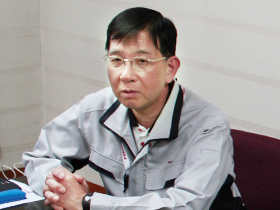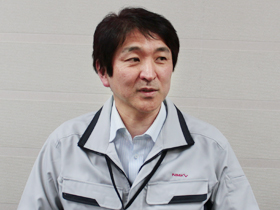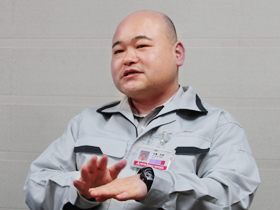Vehicle Project Management
After successfully released the first models (DAYZ and eK WAGON) and the second models (DAYZ ROOX and eK SPACE), the Project Management team has already begun working on a new project. The talk session is held with three members of the team, Hidenori Ono Manager of Project Management Team (Mitsubishi affiliation), Takashi Yagata Engineering Manager of Vehicle Body Design team (Mitsubishi affiliation), and Mitsunari Kojima Engineering Manager of Electrical Appliances Design team (as of March 2014) (Mitsubishi affiliation) to listen to their stories on how they work in NMKV.

▲Ono, Yagata, and Kojima (left to right)
Kei-car project requires “speedy development”
- NMKV’s second release included two Kei-car models. As I understand all of you have been involved in projects that handle various types of automobiles. What is the difference between Kei-car and regular car projects?
Ono:I have been involved in the automobile project management activities for many years. But in fact, it was the very first time to get my hands on Kei-cars. What surprised me first was the speed of development of Kei-car in general. When compared to middle-class sedans, the speed of undertaking adaptive actions and improvements is much faster in Kei-cars regardless of such objectives being new technology, new components, or else.
Kojima:I work in Electrical Appliances Design team. From the experience of being involved both in Kei-cars and regular vehicles, I know that the Kei-car technologies have progressed far beyond the common assumption of the past. Kei-cars tended not to adopt a new technology that was already in widespread use. Today it has changed. There are more and more circumstances where Kei-cars, more than regular vehicles, adopt the latest technologies.
Yagata:I too have more experience with regular vehicles. I acknowledge that the speed of development is the key difference here. Additionally, the Kei-car specification must be restrained so that it satisfies the Kei-standard ultimately. It is another challenge here.
- You said, “speedy development”. Does that mean faster than your expectation?

Ono:When we first proposed the master schedule, many of them were skeptical about its viability, saying that it would kill them. We had to be strong-willed and stay focused to complete our mission; we tried reducing wasteful spending, we tried optimization of work operations, we tried concentrating human resources in a more efficient manner. All of those efforts have paid off in the end and we were able to achieve the milestones laid out in the schedule. Looking back now, I can’t help thinking that my team did really a great job.
Yagata:I recall there was some confusion at the product design side because of the limited amount of time allocated for the designing. I myself have developed one-touch automatic sliding doors for DAYZ ROOX and eK SPACE. It was a new challenge for me to develop sufficiently stable doors while keeping weight balance for super height (tall) wagons. Developing sliding doors that open one-touch automatically from both sides was also a challenge to me. But I also think that such new functions will not be deemed novel anytime soon. We should not forget the idea of speedy development. After all, we are in the world where many competitors were fighting a fierce battle against each other. Frankly speaking, it was a tough job.
NMKV car development: absolutely no compromise for customer satisfaction
- NMKV is a company that creates vehicles for two companies. What is the most distinctive characteristic that NMKV vehicles have?
Ono:The discussions between Nissan, Mitsubishi, and NMKV are conducted by the representatives of each company’s strategy. The result of such discussions carries a great deal of weight. There is a sense of tension that such decisions can’t be reversed, and that we should burn the bridge behind us. Also, NMKV is a company of quick decisions and very clear about its goals and directions it steers toward. I think the most distinctive characteristic of our work is to make vehicles that properly reflect the foregoing.

Yagata:Another characteristic is that we can utilize the technologies created by Nissan and Mitsubishi and adopt them in our products.
Kojima:For example, Nissan has adopted around-view monitors from DAYZ models, which is Nissan’s trail blazing technology. Mitsubishi has adopted multi-around monitors (equipped with bird-eye view function) from eK SPACE models. Not to mention, it was the first models among Kei-cars that adopted such advanced technologies which are not fully democratize even among regular vehicles. As NMKV is allowed to use such technologies developed and owned by two parent companies, it gives us a particularly strong advantage in the world of Kei-car industry where product development goes pretty fast.
-NMKV is a company of planning of Kei-car products and the project management. I assume that NMKV’s goal is to make Kei-cars with quality as good as regular vehicles?
Ono:Yes. Some decades ago, there were practical decisions made in the automobile industry because many thoughts that “It is a thing for Kei cars”. Today it is different. Kei-cars are the ones first equipped with most advanced technologies. I think our customers are also looking for high-quality products among such Kei-cars. We stop asking ourselves like “what a Kei-car should be capable of?” from the product planning and designing phases; because we believe that NMKV’s core mission is to create the most comfortable car for our customers, one of its kind in Japan – coincidentally, such product just turned out to be a Kei-car. Of course, Kei-cars have specific restrictions set within their standard. Beauty of making Kei-car is how to engineer new innovations within the boundary of our product planning. Since both Nissan and Mitsubishi are the developers of regular vehicles, we are quite good at importing an air of the classy appearance of the world of premium saloon onto Kei-car models. From the beginning, the product planning and designs defines the direction here.

Kojima:The newly announced DAYZ ROOX and eK SPACE set the benchmark in the Kei-cars by introducing the rear seat ceiling fans/circulators. We decided to adopt them based on feedback of our customers that “when in a car with large interior space rear seats are hot because the wind from air conditioner doesn’t always reach the rear seats”. If it is a large box-shaped van (1BOX), you can install another air conditioner in the rear. But it would put too much burden on any Kei-Car. We came up with an idea to adopt a circulator. Today many families are using circulators because they can circulate the air efficiently and consume less energy. One of our team members got this idea from a small desk fan put on an office desk. We attached the fan on the ceiling of a Kei-car to try how it works out. And yes, the result was, “this is pleasant enough!”.
I think this is a typical example of unique Kei-car oriented solution. You can’t come up with such idea through regular vehicle-oriented approach.
Create cars through a proposal model: always strive for the best
- Many have a high expectation for NMKV’s future lineups. Tell us about your personal goals.
Yagata:From the standpoint of product design team, we want to propose cars of high-quality to our customers as many as possible, also making them available in the market.
Ono:We want to keep providing our customers something new, first of its kind. I mentioned earlier that the industry is moving fast, which means if even you think you “catch up with rival competitors”, you are only a second away from being pulled far ahead. Therefore, I think the most distinctive characteristic of NMKV is to have enthusiasm to create the best product among others that is first of its kind and deliver it to the market. And I believe such enthusiasm toward cars and vehicles are shared by all of Nissan, Mitsubishi, and NMKV.
- Thank you for your time.
The talk session was held in April 2014. The positions they assume and affiliation they take in this article are as of at the time of the session.






